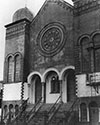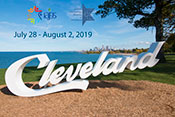Synagogues of Paterson
In Paterson, people formed congregations based on common religious practices, shared occupations, or same old-world origins. Paterson synagogues ranged in size and formality, from members meeting in someone's house or in a modest storefront to gatherings in a utilitarian building, an elaborate Moorish-styled landmark, or a temple designed by a movie theater mogul to resemble his lavish movie palaces. The level of observance varied, and there were Orthodox, Conservative, and Reformed congregations. The synagogues became the focus for individual communities interacting and participating with others through the Jewish communal institutions that the earlier generations had worked so hard to establish. Not only did these congregants remember the Sabbath, but they also insured that their children learned how to read and speak Hebrew so that they could pray and live as Jews. The congregations also helped support the newly formed state of Israel by collecting money and clothing and providing moral support for this massive undertaking. They sold Israel bonds and brought over Israelis to teach in the Hebrew schools. And secular Jews organized several Yiddish-language schools to teach their children yiddishkeit, Yiddish culture. They did this with as much fervor, as did their more observant friends and relatives.
Some of the main synagogues in Paterson were (click on photos for larger imges):
|
Originally an Orthodox congregation formed in 1847 by German Jewish merchants and professional men, joined by some Jews from Bialystok, Poland, eastern Europe's textile center, it eventually became the main Reform Temple in Paterson. [Click on above link for details and photos.]
|

|
|
A conservative congregation, Temple Emanuel developed out of the First Austrian-Hungarian Benevolent Association in 1904. [Click on above link for details and photos.]
|
 |
Congregation B'nai Israel - the Big Shul
In 1886 the Orthodox Jews of Paterson formed a small congregation known as B'nai Israel at Moshe Kassel's home at 94 River Street. In time the congregation moved to Van Houten Street, to 47 Bridge Street, and to 28 Paterson Street. In 1897 the congregation purchased property at 12-14 Godwin Street, where a large and impressive synagogue was built, known popularly as the Godwin Street Shul or di grosse shul, the Big Shul.
|
 |
Ahavath Joseph - the Little Shul
The Little Shul, was established by Rumanian Jews in the early 1900's at 23 Godwin Street. While never reaching the numerical strength of the Big Shul, it played an important role in the religious life of the Jewish community.
|
 |
On January 24, 1954 the Big Shul and the Little Shul combined owing to a declining Jewish Orthodox population. In the 1960's, because of race riots and the fraying of the social infrastructure, the Jewish population no longer felt welcome in the old neighborhood, and most of the members started moving to the Eastside. The merged congregation eventually moved to a beautifully redecorated private residence at 561 Park Avenue. The Orthodox synagogue is currently a yeshiva that draws students from all over New Jersey. They take room and board in two large mansions that border Eastside Park.
|
|
Fair Street Shul (Congregation Anshei Lubavitch)
To keep a Lubavitch presence in Paterson, Congregation Anshai Lubavitch was founded at approximately the beginning of the 20th century on Godwin Avenue.
Originally the Orthodox Shul on Fair Street, formed in 1909, was known as the United Brotherhood Anshai Lodz, popularly called the "Polish Shul" (photo).
In the 1960's, riots and vandalism forced a move to a new home at East 26th Street and Broadway. At this address, the Fair Street congregation was joined by a small Shul, Linat Hatzedek, located on Carroll Street. Together they took the name of United Brotherhood Linat Hatzedek, dropping Anshai Lodz. The combined congregation eventually moved to 685 Broadway, referred to as di stiebel, the study house (see below).
Little further information is known because all records and documents were lost when, in 1980, vandals destroyed its last home at llth Avenue near 26th Street.
The only presence today is in a house on 32nd Street and Broadway known as Anshai Lubavitch Congregation. Both the United Brotherhood Linat Hatzedek and the Lubavitcher congregations joined forces and relocated in Fair Lawn.
|

|
Beth Shalom (Di Stiebel)
Di Stiebel was located in a large house at 685 Broadway, across the street from Barnert Hosital. The combined congregation, later known as Beth Shalom, was a very committed one. All the Paterson synagogues welcomed Jewish refugees from Europe after World War II, but di stiebel drew the most new congregants.
|
 |
Congregation Ohav Sholom
Congregation Ohav Sholom, an Orthodox synagogue, was founded around 1915. Its early members worshiped on the third floor of a Main Street building in the Dublin section of Paterson and later moved to 453 Main Street in the same neighborhood. When Congregation Ohav Sholom was dissolved in 1951, its assets were distributed to Yavneh, the YM-YWHA, Daughters of Miriam, the Fair Lawn Jewish Center, the State of Israel and others. The property is now owned by St. Boniface Church.
|
|
Water Street Shul (Congregation Beth Hamedresh Hagadol)
Another Orthodox synagogue, Congregation Beth Hamedresh Hagadol, known as the Water Street Shul, was located on Water Street (now called Presidential Boulevard) between Arch and Clinton Streets in the "over the river" neighborhood near the silk mills and the Passaic River, nestled between the silk mills and School No. 4. Its members were silk mill workers who came from the Russian Pale of Settlement following the 1905 pogroms there.
As the congregants' fortunes changed and they no longer needed to live near the mills, they started to move out of the neighborhood. Parallelling its members' move to the Eastside in the 1960's, the congregation moved to 115 Vreeland Avenue (photo). When the congregation finally left Paterson, the Vreeland Avenue building became a Baptist church.
|
 |
Mikvah
The first known Mikvah (ritual bath) in Paterson existed at 38 Paterson Street under private auspices. It served the needs of the Orthodox community and introduced showers to those who lacked facilities at home.
After the owners sold the Mikvah, another one was established on Fair Street, under the supervision of the Orthodox Rabbinate.
No Mikvah exists in Paterson today.
Sources:
Jews of Paterson (2012), p. 13-15, 20-25
Our Paterson Jewish Heritage (1987), pp. 8-11 |
|








